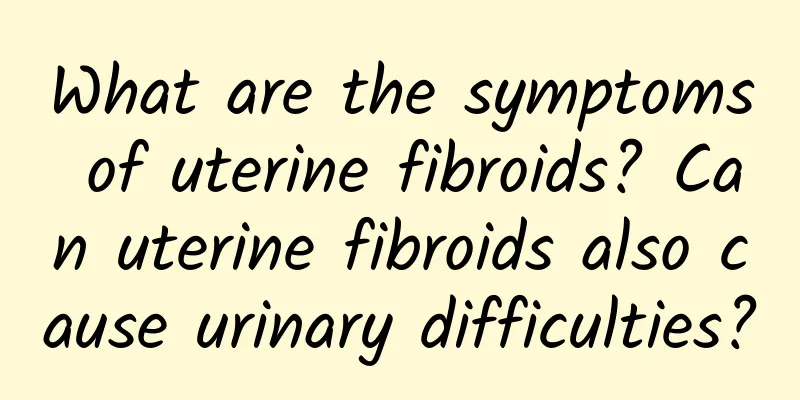What are the symptoms of uterine fibroids? Can uterine fibroids also cause urinary difficulties?

|
In life, people should pay attention to understanding the treatment methods of uterine fibroids. Therefore, patients should pay attention to rest in life, and patients with uterine fibroids should pay attention to their living habits. To avoid further deterioration of uterine fibroids, but patients with uterine fibroids should pay attention to many matters. The premise is to understand the symptoms of uterine fibroids. (1) Increased menstrual volume and prolonged menstruation: more common in large intramural fibroids and submucosal fibroids. Fibroids increase the uterine cavity and the area of the endometrium, affecting uterine contraction and hemostasis during menstruation. In addition, fibroids may squeeze the veins near the tumor, causing congestion and dilation of the uterine venous plexus, resulting in increased menstrual volume and prolonged menstruation. The symptoms of submucosal fibroids are more obvious. If submucosal fibroids are accompanied by necrotic infection, there may be irregular vaginal bleeding or bloody purulent discharge. Long-term increased menstrual volume may lead to secondary anemia, fatigue, palpitations and other symptoms. (2) Lower abdominal mass: The mass cannot be felt within 12 hours of the uterus. When the uterus is more than 3 months pregnant, a hard mass can be felt from the abdomen, which is more obvious when lying flat in the morning. Huge submucosal fibroids can prolapse from the cervix or even outside the vagina, and the patient can prolapse the mass from the vulva. (3) Increased vaginal discharge: Intramural fibroids increase the area of the uterine cavity, increase endometrial secretions, and are accompanied by pelvic congestion, leading to increased vaginal discharge; once the submucosal fibroids of the uterus are infected, there will be a large amount of purulent vaginal discharge. If the fibroids are ulcerated, necrotic, or bleeding, there may be bloody or purulent vaginal discharge with a foul odor. (4) Compression symptoms: If the anterior uterine wall fibroids compress the bladder, it can cause frequent urination and urgency; cervical fibroids can cause dysuria and urinary retention; posterior uterine wall fibroids can cause lower abdominal swelling, constipation and other symptoms. Broad ligament fibroids or giant cervical fibroids develop laterally, embed into the pelvic cavity, compress the ureter, and cause ureteral dilatation, hydronephrosis, and even one kidney failure. (5) Other symptoms: Common symptoms include mild lower abdominal swelling and back pain, which may be aggravated by menstruation. It may cause infertility or miscarriage. Acute lower abdominal pain, vomiting, fever and local tumor tenderness; subserosal myoma pedicle torsion may cause acute abdominal pain; submucosal myoma of the uterus may also cause paroxysmal lower abdominal pain. I hope it can help female friends. Patients with uterine fibroids are very painful. Patients with uterine fibroids should pay attention to their own treatment methods. If you are unfortunately suffering from uterine fibroids, you should pay attention to timely diagnosis and treatment, but patients with uterine fibroids should also pay attention to care matters. |
>>: What are the symptoms of uterine fibroids and how to treat uterine fibroids
Recommend
Summer vulvar leukoplakia should not be underestimated
Vulvar leukoplakia can also appear in the summer,...
Experts on preventing chronic adnexitis give you tips
While enjoying their married life, many women are...
Why does an ectopic pregnancy occur after an IUD is inserted?
Why does ectopic pregnancy occur after IUD insert...
The main causes of dysmenorrhea in women
Dysmenorrhea often occurs between women's hol...
The secret that makes you fatter and fatter, nutritionists say...
In the past, during nutritional consultations for...
Is it normal to have headaches during menstruation?
Is it normal to have headaches during menstruatio...
Three signs of menopause in women
There are three signs that a woman is about to en...
What are the sequelae of severe adnexitis?
Severe adnexitis may lead to infertility, chronic...
Debunking exercise myths: Exercise doesn’t necessarily make you thin!
Q: In order to lose weight, I joined a fitness cl...
What are the methods for detecting endometrial tuberculosis?
There are many methods for checking endometrial t...
Do you know the symptoms of pelvic inflammatory disease?
When it comes to pelvic inflammatory disease, not...
Is it necessary to eat more protein to lose weight? Chicken breast has the lowest fat content, can I eat more of it?
Is protein a holy grail for those who want to los...
Zhao Wei's slimming recipes: Fat-burning vegetable and fruit juices
Zhao Wei, who shot to fame for her role in the Qi...
Can dysmenorrhea cause abnormal vaginal discharge?
Dysmenorrhea does not usually directly cause abno...
What are the side effects of Jin Yuting? Tell you the harm of taking Jin Yuting frequently
Jin Yuting is a kind of emergency contraceptive p...









